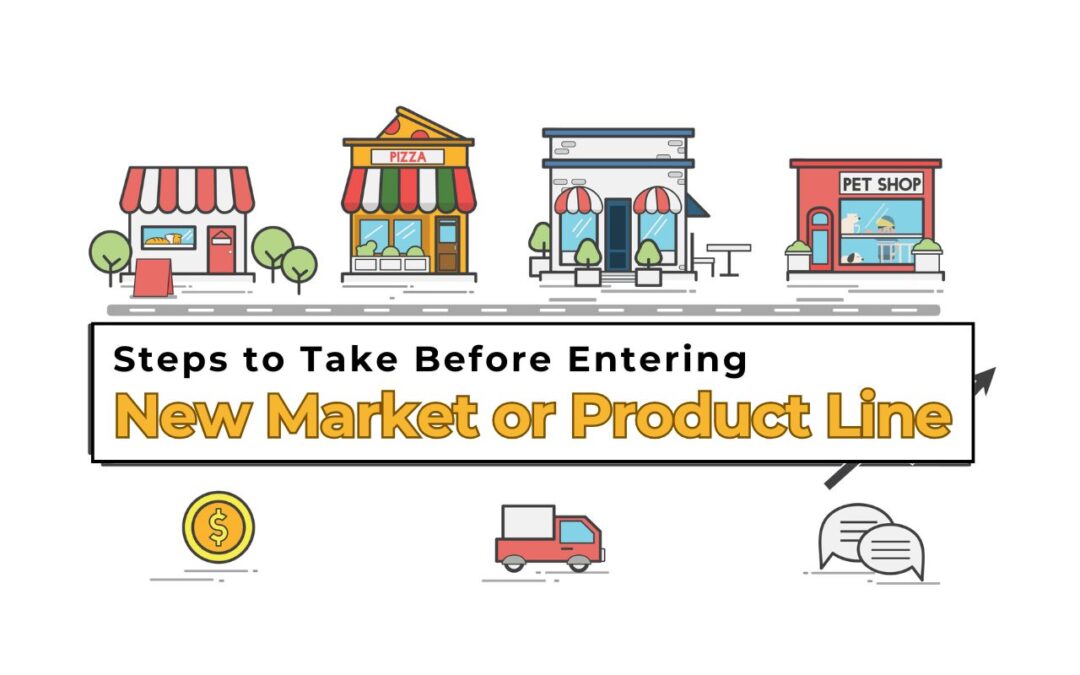Expanding into a new market or launching a new product line can be one of the most exciting yet risky endeavors for any business. Whether you’re an established company seeking growth or a startup ready to diversify, entering uncharted territory demands thoughtful planning and strategic execution. While the rewards can be substantial—greater brand visibility, increased revenue, and competitive advantage—the pitfalls of inadequate preparation can be equally significant.
This blog explores the essential steps businesses must take before entering a new market or launching a new product line. Following a systematic approach will not only help mitigate risks but also provide a strong foundation for success in the long run.
1. Clarify Your Objectives
Before any research or development begins, it’s vital to understand the why behind your decision. What are you hoping to achieve by entering a new market or launching a new product line?
Common goals include:
- Increasing revenue streams
- Diversifying the business portfolio
- Responding to customer demand
- Staying ahead of competitors
- Leveraging existing resources more effectively
By defining your objectives, you ensure that all future steps align with your business vision and long-term strategy.
2. Conduct In-Depth Market Research
Once you have clarity on your objectives, the next step is to conduct comprehensive market research. Understanding the dynamics of the new market is crucial. This includes analyzing:
- Customer demographics and behavior
Who are your potential customers? What are their preferences, pain points, and purchasing patterns? - Cultural and regional nuances
Consumer behavior varies across regions. Something that works well in one area may not translate in another due to cultural, religious, or social differences. - Economic and political stability
Assess the economic environment of the target market. Is it stable enough to support new ventures? Are there political factors that could hinder your entry? - Competitive landscape
Identify existing competitors, their pricing strategies, marketing efforts, and customer base. Understand what sets them apart and where the gaps lie.
Research is not just about collecting data—it’s about gaining insight. Use both qualitative and quantitative methods to draw well-informed conclusions.
3. Validate Market Demand
Having a great product idea isn’t enough. You must ensure there is a real demand for it in the market. Some questions to consider include:
- Is there an existing unmet need your product solves?
- Are customers actively seeking alternatives?
- Would customers be willing to switch to your offering?
Market validation involves gathering direct feedback from potential customers through interviews, surveys, focus groups, or pilot programs. This step helps avoid building products that no one wants or launching in markets with minimal interest.
4. Assess Internal Capabilities
Before diving into a new initiative, evaluate your current resources and capabilities. Can your team handle the expansion? Do you have the technology, talent, and budget to deliver on your promise?
Consider:
- Human resources: Do you need to hire new talent with specific expertise?
- Operational readiness: Can your current supply chain, production, and logistics manage additional demand?
- Financial health: Do you have the capital to support the launch, marketing, and potential setbacks?
Overestimating your internal capabilities is one of the most common mistakes businesses make. A realistic assessment helps you plan more effectively and avoid unnecessary strain on your core operations.
5. Define a Clear Value Proposition
Your value proposition should clearly articulate why a customer should choose your product over others. This is especially critical when entering a new market where brand recognition may be low.
Ask yourself:
- What problem does your product solve?
- How is your solution better or different?
- Why should customers trust a new entrant?
Your messaging must resonate with the local audience and align with their needs and values. A well-defined value proposition becomes the cornerstone of your branding, marketing, and sales strategy.
6. Evaluate Regulatory and Legal Requirements
Compliance is non-negotiable. Every market has its own set of legal and regulatory hurdles, and failure to comply can result in fines, reputational damage, or being barred from the market altogether.
Research the following:
- Licensing and certification requirements
- Import/export restrictions
- Local tax laws and tariffs
- Employment laws and labor standards
- Consumer protection and privacy laws
Engage with legal experts to ensure that your entry strategy meets all legal obligations. This step might seem tedious but is essential for smooth and lawful operation.
7. Build Strategic Partnerships
Forming alliances can ease your entry into a new market. Local partners often bring valuable knowledge of the landscape, access to established networks, and credibility with the target audience.
Consider partnerships with:
- Distributors and resellers
- Marketing agencies
- Local consultants
- Industry associations
Strategic partnerships help you minimize costs, reduce risks, and accelerate market penetration.
8. Develop a Localized Marketing Strategy
A one-size-fits-all approach rarely works when expanding into new markets. Your marketing strategy should be tailored to the cultural, social, and economic context of your audience.
This includes:
- Language adaptation (including local slang or idioms)
- Cultural references in messaging
- Preferred advertising channels
- Seasonality and timing of campaigns
Marketing localization ensures your brand feels relevant and relatable to your new audience, increasing the chances of acceptance and loyalty.
9. Test the Waters with a Pilot Launch
Before going all in, conduct a pilot launch or soft opening in a limited region or with a restricted audience. This phase helps you identify:
- Customer reception and satisfaction
- Operational challenges
- Gaps in service delivery
- Pricing issues
Gather as much feedback as possible during this phase and be ready to iterate. A pilot allows you to learn and adjust without risking your entire investment.
10. Develop a Scalable Operational Plan
Once your pilot yields promising results, focus on scaling your operations effectively. Expansion should not come at the cost of quality or efficiency.
Create detailed operational plans that cover:
- Supply chain logistics
- Inventory management
- Customer service protocols
- Quality control measures
Ensure that your infrastructure, technology, and workforce can support increasing demand without compromising standards.
11. Plan for Risk Management
Entering new territory brings uncertainty. From political instability to cultural misunderstandings, several risks can derail your progress.
Create a robust risk management framework that:
- Identifies potential risks
- Evaluates their impact and likelihood
- Provides mitigation strategies
- Prepares contingency plans
Having a plan in place allows your team to respond quickly and calmly to unexpected issues, minimizing disruption and loss.
12. Align Your Team and Leadership
Internal alignment is just as crucial as external execution. Everyone in your organization—from executives to frontline workers—should understand the vision, goals, and processes related to the new venture.
Hold strategy sessions, conduct training, and maintain open communication channels. When your team is aligned and motivated, execution becomes smoother and more effective.
13. Monitor, Measure, and Optimize
Your job doesn’t end once the product is launched or the market is entered. Continuous monitoring is key to ensuring success and long-term sustainability.
Track metrics like:
- Customer acquisition and retention
- Market share
- Revenue and profitability
- Customer feedback and reviews
Use this data to refine your approach, improve your product, and enhance customer satisfaction. Optimization should be an ongoing process driven by real-world performance.
14. Learn from Competitors and Industry Trends
Stay updated on industry movements, technological innovations, and competitor activities. Continuous learning allows you to stay agile and adapt to changing customer needs and market conditions.
Analyze:
- What competitors are doing differently
- Emerging consumer trends
- Innovations that could disrupt your industry
- Shifts in regulatory policies
By staying informed and responsive, you remain ahead of the curve and prepared for the future.
Final Thoughts
Entering a new market or launching a new product line isn’t just about expansion—it’s about evolution. It challenges businesses to adapt, grow, and innovate. While the risks are real, they can be managed with careful planning, detailed research, and thoughtful execution.
Every step outlined in this blog plays a crucial role in building a sustainable and profitable expansion strategy. Rushing the process or skipping critical stages can lead to costly mistakes. However, with patience, preparation, and persistence, your business can unlock new opportunities and achieve meaningful growth.
Approach every new venture with curiosity, caution, and confidence. The market may be new, but with the right groundwork, your success doesn’t have to be uncertain.













